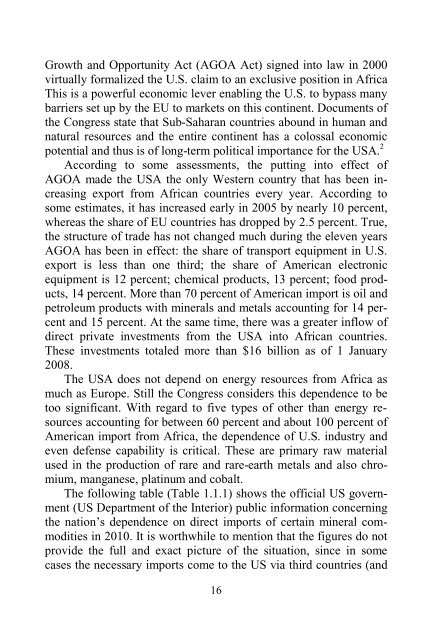L. Fituni, I. Abramova Resource Potential of Africa and Russia's ...
L. Fituni, I. Abramova Resource Potential of Africa and Russia's ...
L. Fituni, I. Abramova Resource Potential of Africa and Russia's ...
You also want an ePaper? Increase the reach of your titles
YUMPU automatically turns print PDFs into web optimized ePapers that Google loves.
Growth <strong>and</strong> Opportunity Act (AGOA Act) signed into law in 2000<br />
virtually formalized the U.S. claim to an exclusive position in <strong>Africa</strong><br />
This is a powerful economic lever enabling the U.S. to bypass many<br />
barriers set up by the EU to markets on this continent. Documents <strong>of</strong><br />
the Congress state that Sub-Saharan countries abound in human <strong>and</strong><br />
natural resources <strong>and</strong> the entire continent has a colossal economic<br />
potential <strong>and</strong> thus is <strong>of</strong> long-term political importance for the USA. 2<br />
According to some assessments, the putting into effect <strong>of</strong><br />
AGOA made the USA the only Western country that has been increasing<br />
export from <strong>Africa</strong>n countries every year. According to<br />
some estimates, it has increased early in 2005 by nearly 10 percent,<br />
whereas the share <strong>of</strong> EU countries has dropped by 2.5 percent. True,<br />
the structure <strong>of</strong> trade has not changed much during the eleven years<br />
AGOA has been in effect: the share <strong>of</strong> transport equipment in U.S.<br />
export is less than one third; the share <strong>of</strong> American electronic<br />
equipment is 12 percent; chemical products, 13 percent; food products,<br />
14 percent. More than 70 percent <strong>of</strong> American import is oil <strong>and</strong><br />
petroleum products with minerals <strong>and</strong> metals accounting for 14 percent<br />
<strong>and</strong> 15 percent. At the same time, there was a greater inflow <strong>of</strong><br />
direct private investments from the USA into <strong>Africa</strong>n countries.<br />
These investments totaled more than $16 billion as <strong>of</strong> 1 January<br />
2008.<br />
The USA does not depend on energy resources from <strong>Africa</strong> as<br />
much as Europe. Still the Congress considers this dependence to be<br />
too significant. With regard to five types <strong>of</strong> other than energy resources<br />
accounting for between 60 percent <strong>and</strong> about 100 percent <strong>of</strong><br />
American import from <strong>Africa</strong>, the dependence <strong>of</strong> U.S. industry <strong>and</strong><br />
even defense capability is critical. These are primary raw material<br />
used in the production <strong>of</strong> rare <strong>and</strong> rare-earth metals <strong>and</strong> also chromium,<br />
manganese, platinum <strong>and</strong> cobalt.<br />
The following table (Table 1.1.1) shows the <strong>of</strong>ficial US government<br />
(US Department <strong>of</strong> the Interior) public information concerning<br />
the nation’s dependence on direct imports <strong>of</strong> certain mineral commodities<br />
in 2010. It is worthwhile to mention that the figures do not<br />
provide the full <strong>and</strong> exact picture <strong>of</strong> the situation, since in some<br />
cases the necessary imports come to the US via third countries (<strong>and</strong><br />
16







